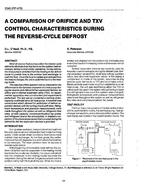Description
Most air source heat pumps utilise the reverse-cycle defrost to eliminate frost that forms on the outdoor heat exchanger during normal winter operations. During defrost, the heat pump is switched from the heating to the defrost mode to provide heat to the outdoor heat exchanger to melt the frost. Once the frost is melted and drained from the heat exchanger, the unit is switched back to the heating mode. The objective of this research was to characterise the differences in the dynamic response of a heat pump during the reverse cycle defrost for two expansion devices, an orifice and a thermal expansion valve (TXV). An experimental apparatus was constructed and experiments performed. The test set-up contained a nominal 3-ton-capacity residential air-to-air-heat pump. A manifold was constructed which allowed for switchover of defrost expansion devices with the turning of a shutoff valve. Refrigerant temperature and pressure measurements were made throughout the system as well as refrigerant flow rates, air-side capacity, compressor/outdoor fan power, and refrigerant level in the accumulator. A detailed comparison of the physical processes that occurred during the defrost for the two expansion devices is provided.
KEYWORDS: comparing, heat pumps, frost, deicing, heat exchangers, controls, experiment, testing, air air heat pumps, fluid flow, properties, outdoor.
Citation: ASHRAE Transactions, vol.96, pt. 1, Atlanta, 1990
Product Details
- Published:
- 1990
- Number of Pages:
- 7
- File Size:
- 1 file , 930 KB
- Product Code(s):
- D-18409




